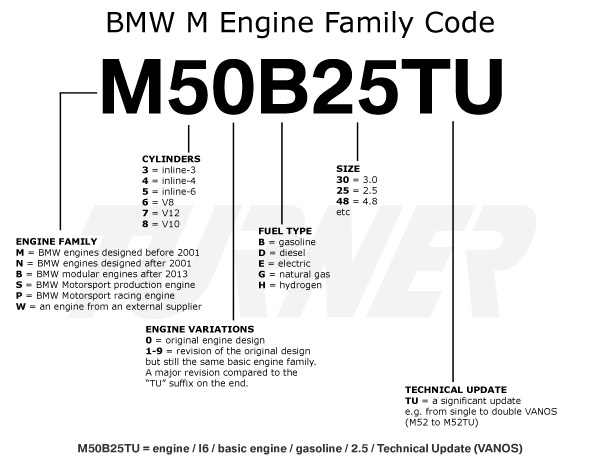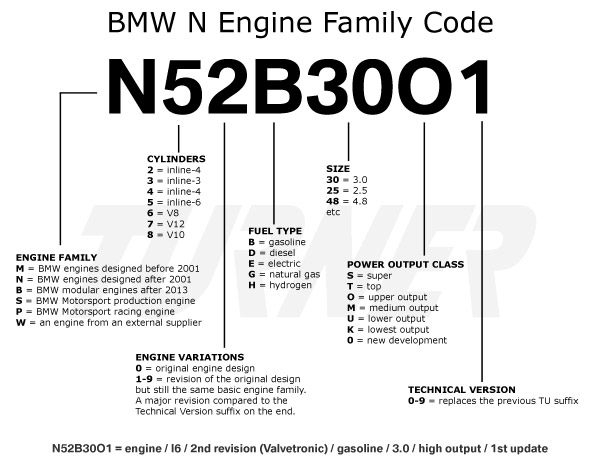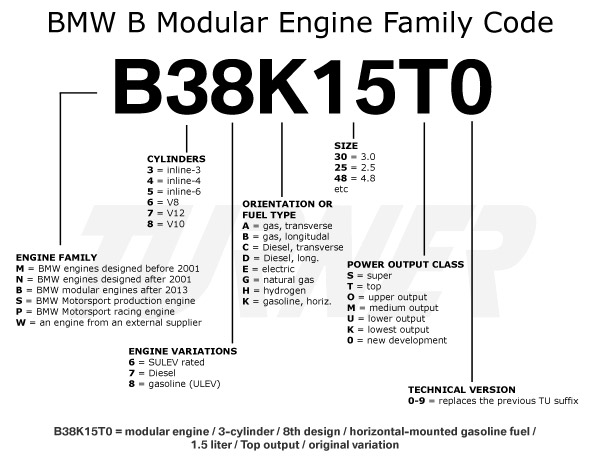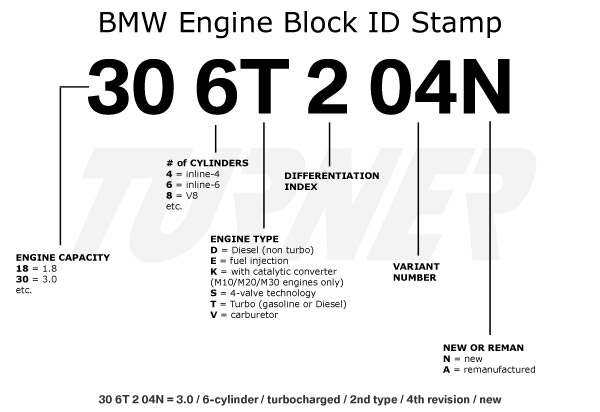
ENGINE 1
BMW Engine Codes
You may come across many acronyms and short hand "codes" while shopping for parts for your BMW. The BMW E-chassis and F-chassis codes are obvious. But another code refers to the type of engine used in your BMW. BMW engines evolve from one generation to the next but generally derive from one original design. For example, the inline-6 cylinder engines in the E34, E36, E39, E46, E53, Z3 and Z4 can all trace their origin to the M50 introduced in 1991. With revisions and updates over the years it's unlikely that parts will simply interchange so knowing the specific engine type can be very helpful when sourcing parts. BMW has gone through several variations on the engine designations; from the 1960s to the 2000s they had the "M" engine family (not to be confused with BMW Motorsport); from the 2000s-2010s they had an N engine code; from the mid 2010s they have a new modular B engine family. Below are charts detailing the BMW engine family codes with a handy de-coder image so you know how each code is broken down. We concentrated on engines used in the US market, as well as BMW Motorsport production (S code) and racing (P code) engines.
This list is some of the more common engine code designations that a US enthusiast may encounter. Engines may change from one type to another based on different factors, including model year and even geographical region. This list includes the engine code, number of cylinders, engine size, the BMW models it's typically found in, and other important information. We have intentionally left off engines not commonly available or known to the US market.
M Code (1964-2006) Regular Production Engines | |||||||||
 | |||||||||
Engine Code |
Engine Size (liters) |
# of Cylinders and layout |
# of Valves |
Camshaft and Valve Timing |
HP Rating |
Torque Rating |
Active Years |
Example Models |
Features |
M10 |
1.6, 1.8, 2.0 |
I4 |
8 |
SOHC |
98-104 |
104-107 |
1964-1985 |
2002, E21 320i, E30 318i |
M31 turbo version = 168hp |
M20 |
2.0-2.7 |
I6 |
12 |
SOHC |
121-168 |
120-180 |
1983-1992 |
E21 323i, E30 325e, E30 325i, E34 525i |
M20B25 = 325i engine M20B27 = 325e engine |
M21 |
2.4 |
I6 |
12 |
SOHC |
84-114 |
112-162 |
1983-1985 |
524td |
turbo diesel |
M30 |
2.5-3.5 |
I6 |
12 |
SOHC |
175-208 |
159-225 |
1968-1993 |
E9 2800, E24 633CSi, E28 535i, E34 535i |
carburetor up to 1975; 1982-1988: 3.4L 8.0:1 compression 1988-1989: 3.5L 9.0:1 compression |
M40 |
1.6, 1.8 |
I4 |
8 |
SOHC |
102-113 |
104-120 |
1987-1991 |
E30 318i |
Euro models |
M42 |
1.8 |
I4 |
16 |
DOHC |
138 |
129 |
1988-1995 |
E30 318is, E36 318i, E36 318ti |
S42B20 used in BTCC racing |
M44 |
1.9 |
I4 |
16 |
DOHC |
138 |
133 |
1996-1999 |
E36 318ti, Z3 1.9 |
US OBD-II models |
M50 |
2.0-2.5 |
I6 |
24 |
DOHC |
150-189 |
140-181 |
1990-1992 |
E34 525i, E36 325i |
non-VANOS valve timing |
M50TU |
2.0-2.5 |
I6 |
24 |
DOHC |
150-189 |
140-180 |
1993-1995 |
E34 525i, E36 325i |
with VANOS valve timing |
M52 |
2.0-2.8 |
I6 |
24 |
DOHC |
150-190 |
140-210 |
1996-1999 |
E36 328i, E39 528i, Z3 2.8 |
VANOS on intake cam |
M52TU |
2.0-2.8 |
I6 |
24 |
DOHC |
150-190 |
140-180 |
1999-2001 |
E39 528i, E46 323i/328i |
VANOS on intake and exhaust cams cable-actuated throttle |
M54 |
2.2-3.0 |
I6 |
24 |
DOHC |
168-228 |
155-221 |
2001-2006 |
E39 525i/530i, E46 325i/330i |
VANOS on intake and exhaust cams Drive-by-Wire throttle |
M56 |
2.5 |
I6 |
24 |
DOHC |
192 |
181 |
2001-2005 |
E46 325i SULEV |
low emissions engine for CA, MA, NY, VT |
M57D30T2 |
3.0 |
I6 |
24 |
DOHC |
265 |
428 |
2009-2011 |
E90 335d, E70 X5 35d |
US-spec M57 Diesel; US-specific SCR emissions system. |
M60 |
3.0-4.0 |
V8 |
32 |
DOHC |
215-282 |
214-295 |
1992-1995 |
E34 530i, E32 740iL |
Nikasil-lined block |
M62 |
3.5-4.6 |
V8 |
32 |
DOHC |
232-342 |
236-354 |
1996-2003 |
-1998 E39 540i, E31 840ci, E53 X5 4.6is |
non-VANOS valve timing |
M62TU |
3.5-4.4 |
V8 |
32 |
DOHC |
235-282 |
254-325 |
1998-2003 |
1999+ E39 540i, E53 X5 4.4i |
with VANOS valve timing |
M70 |
5.0 |
V12 |
24 |
SOHC |
300 |
330 |
1988-1995 |
E31 850i, E32 750iL |
BMW's first V12 |
M73 |
5.4 |
V12 |
24 |
SOHC |
320 |
360 |
1996-1998 |
E31 850ci, E38 750iL |
OBD-II compliant version of M70 |
M73TU |
5.4 |
V12 |
24 |
SOHC |
320 |
360 |
1999-2001 |
E38 750iL |
also used in Rolls-Royce models |
M88/1 |
3.5 |
I6 |
24 |
DOHC |
272 |
243 |
1978-1981 |
E26 M1 |
used exclusively in the M1 supercar |
M88/3 |
3.5 |
I6 |
24 |
DOHC |
282 |
251 |
1983-1989 |
Euro E24 M635CSi |
related closely to S38 used in US M5/M6 |
S Code BMW Motorsport-designed Production Engines (names seem to follow the traditional M code logic above, regardless of year) | |||||||||
S14 |
2.0-2.5 |
I4 |
16 |
DOHC |
195-235 |
155-177 |
1987-1991 |
E30 M3, E30 320is |
based on M88/S38 engine design |
S38 |
3.5-3.8 |
I6 |
24 |
DOHC |
252-335 |
243-295 |
1986-1995 |
E28 M5, E24 M6, E34 M5 |
further development of M88 engine |
S50 EU |
3.0-3.2 |
I6 |
24 |
DOHC |
280-321 |
240-260 |
1993-1999 |
Euro E36 M3, Euro MZ3 |
not based on M50, single and double VANOS |
S50 US |
3.0 |
I6 |
24 |
DOHC |
240 |
225 |
1995 |
US E36 M3, Japan-spec E36 M3 |
directly based on M50 |
S52 |
3.2 |
I6 |
24 |
DOHC |
240 |
240 |
1996-2000 |
US E36 M3, US MZ3 Japan-spec E36 M3 |
directly based on M52 |
S54 |
3.2 |
I6 |
24 |
DOHC |
333-343 |
257-269 |
2001-2008 |
E46 M3, MZ3, Z4 M |
further development of Euro S50B32 |
S55 |
3.0 |
I6 |
24 |
DOHC |
424 |
406 |
2015+ |
F80 M3, F82 M4 |
TVDI - Turbo Valvetronic Direct Injection |
S62 |
4.9 |
V8 |
32 |
DOHC |
394 |
369 |
1999-2003 |
E39 M5, E52 Z8 |
loosely based on M62 but with individual throttles, double VANOS |
S63 |
4.4 |
V8 |
32 |
DOHC |
550 |
500 |
2009-2011 |
E70 X5 M, E71 X6 M |
Motorsport-built version of N63 |
S63TU |
4.4 |
V8 |
32 |
Valvetronic |
560 |
502 |
2011- |
F10 M5, F12 M6 |
S63 with Valvetronic and more boost |
S63T2 |
4.4 |
V8 |
32 |
Valvetronic |
567 |
553 |
2015- |
F85 X5M, F86 X6M |
M5 S63TU with higher compression |
S65 |
4.0-4.4 |
V8 |
32 |
DOHC |
414-444 |
300-320 |
2008-2012 |
E90 M3, E92 M3 GTS |
based on S85 V10 last naturally-aspirated M engine |
S70 |
5.6 |
V12 |
48 |
DOHC |
380 |
410 |
1994-1995 |
E31 850CSi |
Motorsport evolution of M70 engine |
S70/2 |
6.0-6.1 |
V12 |
48 |
DOHC |
627-680 |
480 |
1994-1997 |
McLaren F1 |
not based on an M70 engine shares many design points with Euro S50 |
S85 |
5.0 |
V10 |
60 |
DOHC |
500 |
384 |
2006-2010 |
E60 M5, E63 M6 |
technology derived from Formula 1 |
P Code BMW Motorsport Race Engines (names seem to follow the traditional M code logic above, regardless of year) | |||||||||
M12/7 |
1.5-2.0 |
I4 |
16 |
DOHC |
250-300+ |
x |
1968-1972 |
2002, Formula 2, 320i |
based on M10 4-cylinder but with 4-valve heads; naturally-aspirated |
M12/M13/1 |
1.4-1.5 |
I4 |
16 |
DOHC |
350-1,300 |
x |
1979-1988 |
320i Group 5, March GTP, Brabham Formula 1 |
single turbo, decimated n/a competitors before turbos were outlawed; up to 5.5bar of boost in F1 |
M49 |
3.5 |
I6 |
24 |
DOHC |
430+ |
310+ |
1974-1976 |
3.5 CSL |
BMW Motorsport and Schnitzer developed engine for IMSA and Le Mans. Loosely based on M12/7 race engine. |
S42B20 |
2.0 |
I4 |
16 |
DOHC |
300 |
x |
1992-1998 |
E36 318is BTCC |
SuperTouring engine, based on M42 4-cyl |
P50B32 |
3.2-3.4 |
I6 |
24 |
DOHC |
400-425 |
x |
1997-2001 |
E36 M3 GTR, E46 M3 |
based on Euro S50B32, used in E36 PTG racecars and first E46 PTG cars |
S70/3 |
6.0 |
V12 |
48 |
DOHC |
650+ |
x |
1995-1997 |
McLaren F1 GTR |
winner of 1995 24 Hours of Le Mans; similar in design to S70/2 |
P75B60 |
6.0 |
V12 |
48 |
DOHC |
650+ |
x |
1998-2001 |
BMW V12 LMR Prototype, E53 X5/LM |
winner of 1999 24 Hours of Le Mans; ground-up evolution of S70/3 |
P54B32 |
3.2-3.4 |
I6 |
24 |
DOHC |
425-450 |
x |
2001-2003 |
E46 M3 |
race engine based on S54 street engine; used in ALMS prior to 4.0 P60 V8 |
P60B40 |
4.0 |
V8 |
32 |
DOHC |
444-470 |
x |
2003-2005 |
E46 M3 GTR |
race-only engine not based on a true production model |
P52/P54B20 |
2.0 |
I6 |
24 |
DOHC |
260+ |
x |
2001-2005 |
E46 320i WTCC |
Touring Car engine based on M54 with individual throttles; 9,000 RPM rev limit |
P45B20 |
2.0 |
I4 |
16 |
DOHC |
275 |
x |
2005-2012 |
E90 320si WTCC |
based on N45 production engine from homologation special E90 320si |
P65 |
4.0 |
V8 |
32 |
DOHC |
480+ |
x |
2010-2011 |
E92 M3 GT |
evolution of P60B40 |
P65B44 |
4.4 |
V8 |
32 |
DOHC |
480 (est.) |
355 (est.) |
2011- |
E89 Z4 GTE, E89 Z4 GT3 |
based on S65B44 from M3 GTS; engine differences between GT3 and GTE versions |
P66 |
4.0 |
V8 |
32 |
DOHC |
500 (est.) |
369 (est.) |
2012- |
E92 M3 DTM |
clean-sheet design, not related to any production engine |
P84 |
3.0 |
V10 |
40 |
Pneumatic |
925+ |
x |
2004-2005 |
WilliamsBMW F1 |
19,000 RPM rev limit; 1,500km lifespan (4 times longer than 2002 F1 rules) |
P86 |
2.4 |
V8 |
32 |
Pneumatic |
720+ |
x |
2006-2009 |
BMW Sauber F1 Team |
19,000 RPM rev limit |
N Code (2006-2015) Regular Production Engines | |||||||||
Beginning in the early-2000s, BMW revised their naming strategy to get more info out of each character and make it easier to understand updates and revisions. The new BMW engine designs were ground-up fresh designs with groundbreaking advancements in materials and technology. Turbocharging and Diesel engines were also introduced to the US market so BMW had to be more specific in their engine coding. | |||||||||
 | |||||||||
Engine Code |
Engine Size (liters) |
# of Cylinders and layout |
# of Valves |
Camshaft and Valve Timing |
HP Rating |
Torque Rating |
Active Years |
Example Models |
Features |
N20 |
2.0 |
I4 |
16 |
DOHC |
241 |
258 |
2012- |
F30 320i/328i |
single twin-scroll turbo, Valvetronic, direct injection |
N51 |
3.0 |
I6 |
24 |
Valvetronic |
230 |
199 |
2007-2011 |
E90 328i SULEV |
SULEV low emissions engine |
N52B30K0 |
3.0 |
I6 |
24 |
Valvetronic |
215 |
184 |
2006 |
E90 325i |
also known as 'low output' N52KP |
N52B30M1 |
3.0 |
I6 |
24 |
Valvetronic |
230 |
199 |
2007-2012 |
E90/E92 328i, Z4 3.0i |
Medium-output N52KP |
N52B30O1 |
3.0 |
I6 |
24 |
Valvetronic |
255 |
221 |
2006-2012 |
E90 330i, E60 528i, Z4 3.0si |
High-output N52KP |
N52B30T1 |
3.0 |
I6 |
24 |
Valvetronic |
240 |
230 |
2010-2012 |
F10 528i, F25 X3 28i |
Top-output N52KP; highest torque of the N52 family; also known internally as N52T |
N53 |
2.5-3.0 |
I6 |
24 |
Valvetronic |
190-270 |
173-240 |
2007-2011 |
Euro E90 325i, Euro E60 523i, Euro F10 525i |
Euro-spec version for lower market Euro models |
N54 |
3.0 |
I6 |
24 |
DOHC |
306-335 |
295-332 |
2007-2010 |
E90/E92 335i, E60 535i, E82 1M |
twin-turbo, direct injection |
N55 |
3.0 |
I6 |
24 |
Valvetronic |
302-315 |
300-330 |
2010- |
E92 335i, F30 335i |
single twin-scroll turbo, Valvetronic, direct injection |
N62 |
3.6-4.8 |
V8 |
32 |
Valvetronic |
272-367 |
262-369 |
2001-2010 |
E60 545i/550i, E65 745/750, E70 X5 4.8 |
naturally aspirated, Valvetronic |
N63 |
4.4 |
V8 |
32 |
DOHC |
402 |
440 |
2008- |
F10 550i, E71 X6 50i, F02 750Li |
twin turbo; 1st gen N63 design (N63B44O0); subject to BMW "Customer Care Package" recall |
N63TU |
4.4 |
V8 |
32 |
TVDI |
445 |
480 |
2013- |
F10/13 550i/650i, F15/16 X5/X6 50i, F02 750Li |
TVDI - Turbo Valvetronic Direct Injection; 2nd gen N63 design (N63B44O1) |
N63TU2 (N63R) |
4.4 |
V8 |
32 |
TVDI |
445 |
480 |
2015- |
G12 750Li |
TVDI - Turbo Valvetronic Direct Injection; 3rd gen N63 design (N63B44O2) |
N73 |
6.0 |
V12 |
48 |
Valvetronic |
439 |
440 |
2003-2008 |
E65 760Li |
naturally aspirated, Valvetronic, direct injection |
N74 |
6.0-6.6 |
V12 |
48 |
Valvetronic |
540-560 |
550-580 |
2009+ |
F02 760Li, Rolls-Royce |
twin-turbo, Valvetronic |
MINI Production Engines, 2002-2014 | |||||||||
W10 |
1.6 |
I4 |
16 |
DOHC |
114 |
110 |
2002-2006 |
MINI R50 |
Tritec Pentagon engine, co-developed with Chrysler |
W11 |
1.6 |
I4 |
16 |
DOHC |
160-168 |
150-160 |
2002-2007 |
MINI R52 R53 |
supercharged version of W10 |
N12 |
1.6 |
I4 |
16 |
DOHC |
118 |
118 |
2007-2010 |
MINI R56/R57 |
aka EP6 Prince engine, co-developed with Peugeot; naturally-aspirated |
N14 |
1.6 |
I4 |
16 |
DOHC |
171 |
177 |
2007-2010 |
MINI R56S R57S |
aka EP6DTS Prince engine, co-developed with Peugeot; turbocharged |
N16 |
1.6 |
I4 |
16 |
DOHC |
118 |
114 |
2011-2014 |
MINI R56/R57 |
naturally-aspirated; more closely related to BMW N20 engine |
N18 |
1.6 |
I4 |
16 |
DOHC |
181 |
191 |
2011-2014 |
MINI R56S/R57S |
turbocharged; more closely related to BMW N20 engine |
B Code Modular Production Engines (modular engines will be shared among BMW and MINI platforms starting in 2014) | |||||||||
For the 2014 model year BMW began introducing a new modular engine family. The first cars to receive the new "B series" engines were the i8 hybrid sports car and the Mini model range. Both of these cars shared a 3-cylinder turbocharged direct injection with Valvetronic. The modular engine family uses gasoline and diesel engines that share common components and architecture. 60% of the gasoline engine parts are shared among multiple size and cylinder counts (the 3-cylinder shares many of its components with the 4 and 6-cylinder engines). Engine size and layout jumps in 500cc increments - 1.5L I3, 2.0L I4, 2.5L I6, 3.0L I6, etc. | |||||||||
 | |||||||||
Engine Code |
Engine Size (liters) |
# of Cylinders and layout |
# of Valves |
Camshaft and Valve Timing |
HP Rating |
Torque Rating |
Active Years |
Example Models |
Features |
B36 |
1.5 |
I3 |
12 |
Valvetronic |
120-175 |
? |
2014+ |
MINI F5x |
first of the modular BMW engines |
B37 |
1.5 |
I3 |
12 |
DI |
95-168 |
? |
2014+ |
F30 LCI 320d, MINI F5x |
modular Diesel |
B38A12U0 |
1.2 |
I3 |
12 |
Valvetronic |
100 |
133 |
2014+ |
MINI F5x |
Lower output B38A |
B38A15M0 |
1.5 |
I3 |
12 |
Valvetronic |
134 |
162 |
2014+ |
MINI Cooper F5x |
Medium output B38 |
B38A15T0 |
1.5 |
I3 |
12 |
Valvetronic |
227 |
236 |
2014+ |
MINI F5x |
Top output B38A |
B38K15T0 |
1.5 |
I3 |
12 |
Valvetronic |
231 |
236 |
2014+ |
i8 |
Top B38 output |
B48 |
2.0 |
I4 |
16 |
Valvetronic |
192-231 |
206-258 |
2014+ |
F30 LCI, MINI F5x |
replaces N20 engine |
B48A20M0 |
2.0 |
I4 |
16 |
Valvetronic & DI |
189 |
207 |
2014+ |
MINI F5x Cooper S |
Medium output |
B48B20M0 B48B20A |
2.0 |
I4 |
16 |
Valvetronic & DI |
189 |
207 |
2016+ |
F22 220i, F3X LCI 320i/420i |
TVDI - Turbo Valvetronic Direct Injection, Medium output |
B48B20O0 |
2.0 |
I4 |
16 |
Valvetronic & DI |
225 |
258 |
2016+ |
F22 225i |
TVDI - Turbo Valvetronic Direct Injection, Optimal/High output |
B48B20O0 B48B20B |
2.0 |
I4 |
16 |
Valvetronic & DI |
249 |
258 |
2016+ |
F22 230i, F3X LCI 330i/430i |
TVDI - Turbo Valvetronic Direct Injection, Optimal/High output |
B58B30M0 |
3.0 |
I6 |
24 |
Valvetronic & DI |
322 |
332 |
2016+ |
F3X LCI 340i/440i |
TVDI - Turbo Valvetronic Direct Injection, Medium output |
B58B30O0 |
3.0 |
I6 |
24 |
Valvetronic & DI |
335 |
369 |
2016+ |
F22 M240i |
TVDI - Turbo Valvetronic Direct Injection, Optimal/High output |
BMW also has a different numbering system for internal production and assembly use. This is a code stamped on the side of the engine block and is used at the BMW assembly plant and during other servicing when the actual identity of the engine is in question. Most of the time this code is stamped into a flat section on the driver's side (LHD) of the block. However, note that not all blocks were stamped. The stamp will likely be 3 lines of characters -
Engine ID stamp (see breakdown below)
Engine number / serial number
Block part number (for parts ETK or RealOEM programs)
Here is the breakdown for the engine ID stamp:

Contact Us to Own a BMW from your dreams: A Timeless Classic
Are you ready to own a piece of automotive history? The BMW is not just a car; it’s a symbol of driving excellence and motorsport heritage. With its impeccable design, exhilarating performance, and storied racing pedigree, the Classic BMW is a must-have for any car enthusiast or collector.
Why Buy from Us?
- Expertly Maintained: Our Classic BMW cars are meticulously inspected and maintained to ensure they are in pristine condition.
- Authenticity Guaranteed: Each car comes with verified provenance and documentation, assuring you of its authenticity and history.
- Personalized Service: We offer a tailored buying experience, including detailed consultations to understand your needs and preferences.
- Exclusive Inventory: We have a selection of the finestClassic BMW cars, including rare models and limited editions.
Contact Information
If you’re interested in purchasing aClassic BMW cars, we’d love to hear from you. Contact us to schedule a viewing or to learn more about our current inventory.
E-Mail: bavarianoldschool@gmail.com
Website:www.bavarianoldschool.com





